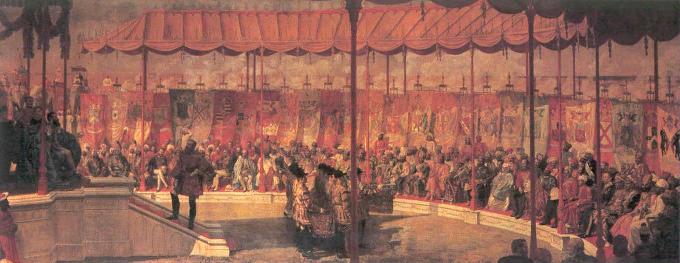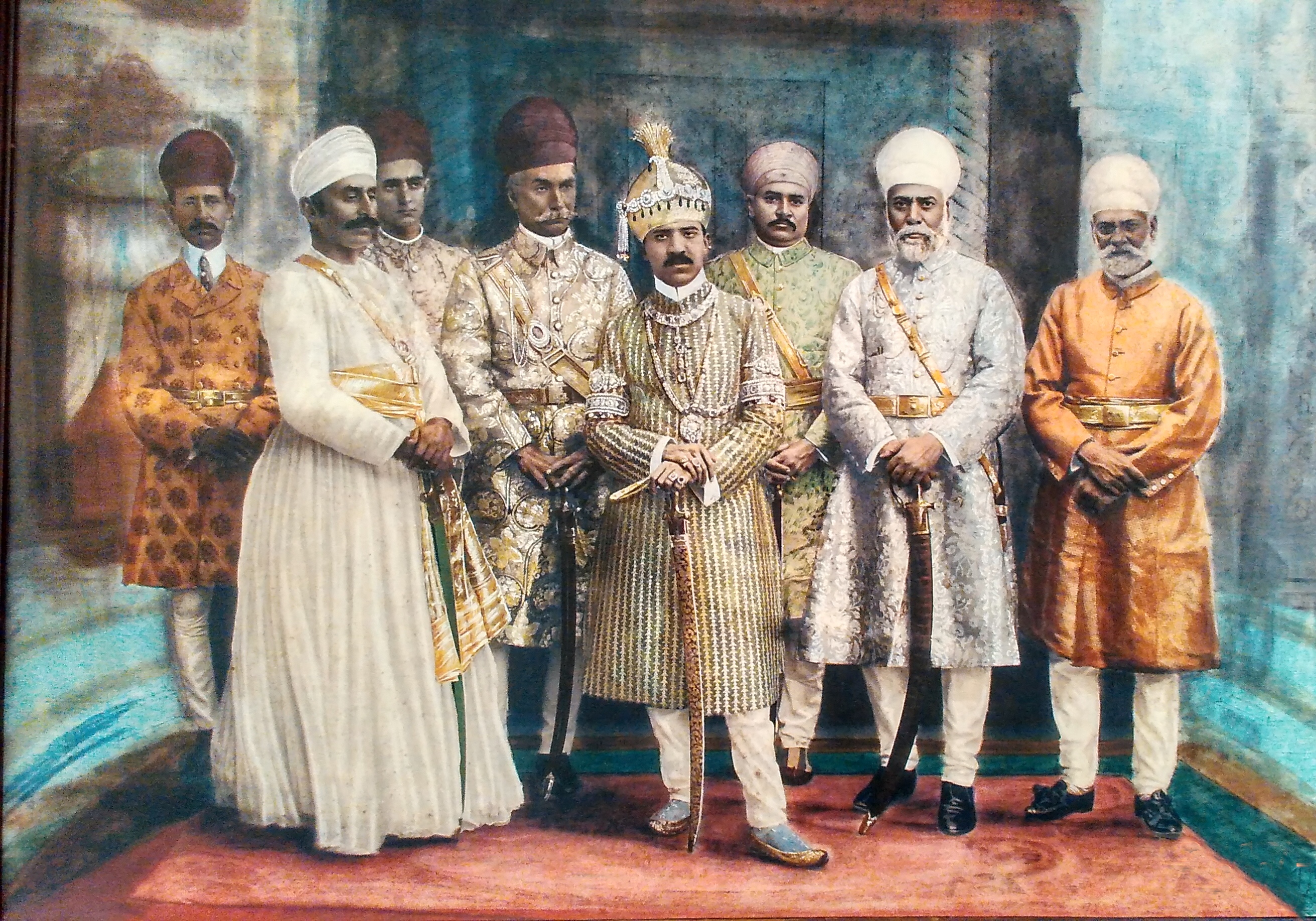|
Vincent Jerome Esch
Vincent Jerome Esch, (20 July 1876 – 9 December 1950) was a British architect who worked in India. He is regarded as a pioneer of the Indo-Saracenic architectural style, which developed during the British rule in the Indian subcontinent. Born in London, he moved to India in 1898, and was appointed assistant engineer on the Bengal Nagpur Railway before setting himself up as an architect in Calcutta.. In 1914, he was invited to Hyderabad by the Nizam, to design some major public buildings. He designed the Kacheguda railway station, the High Court, the City College, and the Osmania General Hospital in Hyderabad. He was in Hyderabad until 1921, then returned to Calcutta. He later returned to England, and died in 1950. Early life and background He was born the son of C.A. Bernard Esch, a merchant banker of Blackheath, London and educated at Mount St Mary's College. He then trained as an architect in London. Career Early career Esch moved to India in 1898 and was appoin ... [...More Info...] [...Related Items...] OR: [Wikipedia] [Google] [Baidu] |
Victoria Memorial, Kolkata
The Victoria Memorial is a large marble monument in the Maidan in Central Kolkata (Calcutta), having its entrance on the Queen's Way. It was built between 1906 and 1921 by the British Raj. It is dedicated to the memory of Queen Victoria, the Empress of India from 1876 to 1901. It is the largest monument to a monarch anywhere in the world. It stands at of gardens and is now a museum under the control of the Ministry of Culture, Government of India. Possessing prominent features of the Indo-Saracenic architecture, it has evolved into one of the most popular attractions in the city. History According to historian Durba Ghosh, Viceroy of India Lord Curzon's "plans for the historical museum that became the Victoria Memorial Hall predated Victoria's death in 1901. When he addressed a group at the Asiatic Society, he admitted that he had always planned to build such a historical museum. The queen's death had provided an appropriate occasion to monumentalize the empire." After ... [...More Info...] [...Related Items...] OR: [Wikipedia] [Google] [Baidu] |
Delhi Durbar
The Delhi Durbar ( lit. "Court of Delhi") was an Indian imperial-style mass assembly organized by Britain at Coronation Park, Delhi, India, to mark the succession of an Emperor or Empress of India. Also known as the Imperial Durbar, it was held three times, in 1877, 1903, and 1911, at the height of the British Empire. The 1911 Durbar was the only one that a sovereign, George V, attended. The term was derived from the common Persian term '' durbar''. Durbar of 1877 Called the "Proclamation Durbar", the Durbar of 1877, for which the organisation was undertaken by Thomas Henry Thornton, was held beginning on 1 January 1877 to proclaim Queen Victoria as Empress of India by the British. The 1877 Durbar was largely an official event and not a popular occasion with mass participation like later durbars in 1903 and 1911. It was attended by the 1st Earl of Lytton— Viceroy of India, maharajas, nawabs and intellectuals. Inside the Victoria Memorial in Calcutta is an inscription ... [...More Info...] [...Related Items...] OR: [Wikipedia] [Google] [Baidu] |
British People In Colonial India
British may refer to: Peoples, culture, and language * British people, nationals or natives of the United Kingdom, British Overseas Territories and Crown Dependencies. * British national identity, the characteristics of British people and culture * British English, the English language as spoken and written in United Kingdom of Great Britain and Northern Ireland and, more broadly, throughout the British Isles * Celtic Britons, an ancient ethno-linguistic group * Brittonic languages, a branch of the Insular Celtic language family (formerly called British) ** Common Brittonic, an ancient language Other uses *People or things associated with: ** Great Britain, an island ** British Isles, an island group ** United Kingdom, a sovereign state ** British Empire, a historical global colonial empire ** Kingdom of Great Britain (1707–1800) ** United Kingdom of Great Britain and Ireland (1801–1922) * British Raj, colonial India under the British Empire * British Hong Kong, colonial ... [...More Info...] [...Related Items...] OR: [Wikipedia] [Google] [Baidu] |
Commanders Of The Royal Victorian Order
Commander (commonly abbreviated as Cmdr.) is a common naval officer rank as well as a job title in many army, armies. Commander is also used as a rank or title in other formal organizations, including several police forces. In several countries, this naval rank is termed as a frigate captain. Commander is also a generic term for an officer commanding any armed forces unit, such as "platoon leader, platoon commander", "brigade commander" and "Squadron (army), squadron commander". In the police, terms such as "borough commander" and "incident commander" are used. Commander as a naval and air force rank Commander is a rank used primarily in Navy, navies, and is very rarely used as a rank in army, armies. In most armies, the term "commander" is used as a job title. For example, in the US Army, an officer with the rank of captain (armed forces), captain (Ranks and insignia of NATO, NATO rank code OF-2) may hold the title of "company (military unit), company commander (United Stat ... [...More Info...] [...Related Items...] OR: [Wikipedia] [Google] [Baidu] |
Architects From London
An architect is a person who plans, designs, and oversees the construction of buildings. To practice architecture means to provide services in connection with the design of buildings and the space within the site surrounding the buildings that have human occupancy or use as their principal purpose. Etymologically, the term architect derives from the Latin , which derives from the Greek (''-'', chief + , builder), i.e., chief builder. The professional requirements for architects vary from location to location. An architect's decisions affect public safety, and thus the architect must undergo specialised training consisting of advanced education and a ''practicum'' (or internship) for practical experience to earn a license to practice architecture. Practical, technical, and academic requirements for becoming an architect vary by jurisdiction though the formal study of architecture in academic institutions has played a pivotal role in the development of the profession. Origins Th ... [...More Info...] [...Related Items...] OR: [Wikipedia] [Google] [Baidu] |
1950 Deaths
Events January * January 1 – The International Police Association (IPA) – the largest police organization in the world – is formed. * January 5 – 1950 Sverdlovsk plane crash, Sverdlovsk plane crash: ''Aeroflot'' Lisunov Li-2 crashes in a snowstorm. All 19 aboard are killed, including almost the entire national ice hockey team (VVS Moscow) of the Soviet Air Force – 11 players, as well as a team doctor and a masseur. * January 6 – The UK recognizes the People's Republic of China; the Republic of China severs diplomatic relations with Britain in response. * January 7 – A fire in the St Elizabeth's Ward of Mercy Hospital in Davenport, Iowa, United States, kills 41 patients. * January 9 – The Israeli government recognizes the People's Republic of China. * January 12 – Submarine collides with Sweden, Swedish oil tanker ''Divina'' in the Thames Estuary and sinks; 64 die. * January 13 – Finland forms diplomatic relations with the People's Republic of Chin ... [...More Info...] [...Related Items...] OR: [Wikipedia] [Google] [Baidu] |
1876 Births
Events January * January 1 ** The Reichsbank opens in Berlin. ** The Bass Brewery Red Triangle becomes the world's first registered trademark symbol. *January 27 – The Northampton Bank robbery occurs in Massachusetts. February * February 2 ** The National League of Professional Base Ball Clubs is formed at a meeting in Chicago; it replaces the National Association of Professional Base Ball Players. Morgan Bulkeley of the Hartford Dark Blues is selected as the league's first president. ** Third Carlist War (Spain): Battle of Montejurra – The new commander General Fernando Primo de Rivera marches on the remaining Carlist stronghold at Estella, where he meets a force of about 1,600 men under General Carlos Calderón, at nearby Montejurra. After a courageous and costly defence, Calderón is forced to withdraw. * February 14 – Alexander Graham Bell applies for a U.S. patent for the telephone, as does Elisha Gray. * February 19 – Third Carlist War ... [...More Info...] [...Related Items...] OR: [Wikipedia] [Google] [Baidu] |
Mir Osman Ali Khan
Mir Osman Ali Khan, Asaf Jah VII (5 or 6 April 1886 – 24 February 1967) was the last Nizam (ruler) of Hyderabad State, the largest state in the erstwhile Indian Empire. He ascended the throne on 29 August 1911, at the age of 25 and ruled the State of Hyderabad between until 1948, when the Indian Union annexed it. He was styled as His Exalted Highness (H.E.H) the Nizam of Hyderabad, and was widely considered one of the world's wealthiest people of all time. With some estimates placing his wealth at 2% of U.S. GDP, his portrait was on the cover of ''Time'' magazine in 1937. As a semi-autonomous monarch, he had his mint, printing his currency, the Hyderabadi rupee, and had a private treasury that was said to contain £100 million in gold and silver bullion, and a further £400 million of jewels (in 2008 terms). The major source of his wealth was the Golconda mines, the only supplier of diamonds in the world at that time. Among them was the Jacob Diamond, valued at some ... [...More Info...] [...Related Items...] OR: [Wikipedia] [Google] [Baidu] |
Great Musi Flood Of 1908
The Great Musi Flood was a devastating flood that occurred on 28 September 1908 in Hyderabad on the banks of the Musi River. The city of Hyderabad was the capital of the Hyderabad State, ruled by the Nizam, Mir Mahbub Ali Khan. The flood, locally known as ''Thughyani Sitambar'', shattered the life of the people living in Hyderabad, killing 50,000 people It washed away three bridges — the Afzal, Mussallam Jung and Chaderghat, such that the Puranapul became the only link between the two parts of the city. Flooding of Hyderabad The Musi River was the cause of frequent flood devastation of Hyderabad city until the early 20th century. It had begun to swell dangerously on 27 September. The first flood warning came at 2 AM when the water flowed over Puranapul bridge. By 6 AM there was a cloudburst. The flood breached on Tuesday, 28 September 1908: the river rose 60 feet, flowing through the city. In 36 hours, 17 inches of rainfall was recorded, and the water level at A ... [...More Info...] [...Related Items...] OR: [Wikipedia] [Google] [Baidu] |
Chhatri
''Chhatri'' are semi-open, elevated, dome-shaped pavilions used as an element in Indo-Islamic architecture and Indian architecture. They are most commonly square, octagonal, and round. Originating as a canopy above tombs, they largely serve as decorative elements as opposed to functional elements. The earliest examples of chhatri being used in the Indian Subcontinent were found in the Shrine of Ibrahim in Bhadreswar, constructed between 1159 and 1175 AD. Chhatri are found particularly within Mughal architecture. The most notable surviving examples today are to be found at Humayun's Tomb in Delhi and the Taj Mahal in Agra. The Berar Sultanate in the Deccan added chhatris on buildings in its various capitals. Chhatri have also been used in Rajasthan and other parts of the Indian Subcontinent by both Muslim and Hindu rulers. They are primarily used to manipulate skylines, an important aspect of Rajasthani architecture. For instance, they may be added to building roofs, ... [...More Info...] [...Related Items...] OR: [Wikipedia] [Google] [Baidu] |








